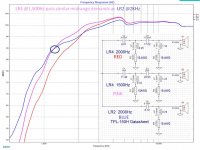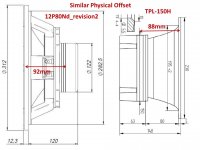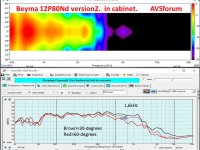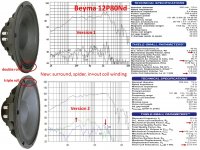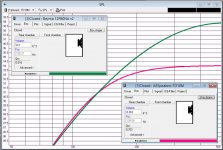When you pay $500 for a tweeter, you probably want a midbass which matches the efficiency and dynamics.
One reason the Beyma 12P80Ndv2 is frequently recommended for the TPL-150H.
(The Ciare ndh12-3 specs also look good. The cast motor frame allow rear ventilation of the suspension spider.)
With the Beyma 12P80Ndv2 you will need to accept a sealed -F3 = 140Hz, which you can attempt to blend with the baffle step into an equalized 18" woofer.
The impedance of the Beyma TPL-150H is a pure resistance, and this allows almost perfect LR4 slopes using textbook passive circuits.
At 1600Hz, the TPL-150H horn's 80H polar response is a "decent" match to curved cone 12" midbass like the TD12M or Beyma 12P80Ndv2, and also using a steep crossover slope like LR4 @1600Hz helps reduce higher frequency cone breakup. The physical offset of the 12P80Ndv2 is very close to the TPL-150H, and if after cabinet construction you want to null this difference, you can try shallow routing-in one driver.
If you bi-amp, a single 18" woofer with enough watts can match the SPL of the Beyma 12P80Nd. Two 18" woofers are required to match the efficiency of the 12P80Nd when the speaker box is not directly against the walls.
One reason the Beyma 12P80Ndv2 is frequently recommended for the TPL-150H.
(The Ciare ndh12-3 specs also look good. The cast motor frame allow rear ventilation of the suspension spider.)
With the Beyma 12P80Ndv2 you will need to accept a sealed -F3 = 140Hz, which you can attempt to blend with the baffle step into an equalized 18" woofer.
The impedance of the Beyma TPL-150H is a pure resistance, and this allows almost perfect LR4 slopes using textbook passive circuits.
At 1600Hz, the TPL-150H horn's 80H polar response is a "decent" match to curved cone 12" midbass like the TD12M or Beyma 12P80Ndv2, and also using a steep crossover slope like LR4 @1600Hz helps reduce higher frequency cone breakup. The physical offset of the 12P80Ndv2 is very close to the TPL-150H, and if after cabinet construction you want to null this difference, you can try shallow routing-in one driver.
If you bi-amp, a single 18" woofer with enough watts can match the SPL of the Beyma 12P80Nd. Two 18" woofers are required to match the efficiency of the 12P80Nd when the speaker box is not directly against the walls.
Attachments
LineSource said:Two 18" woofers are required to match the efficiency of the 12P80Nd when the speaker box is not directly against the walls

White line = Beyma 12p80nd in 15 litre sealed box. Yellow line = Faital 18fh500 in 20 litre sealed box. In 2pi (ground plane, no walls). (dB scale is 2dB per bar)
(if you extent the plot to the full range, the Beyma does eventually get 1.8dB over on the Faital (predicted response), but there are 18"ers that are 100dB efficient up that high as well. They're just not very common.
Fane Colossus Prime 18XS ie:

COLOSSUS PRIME 18XS
(not that you should generally run 18's that high, obviously. The Faitals will take it..the XS won't.)
Last edited:
What's your sub setup? Is there any possibility that the sub could be crossed at higher than 100 Hz?
If you're using the TPL-150 and not the TPL-150/H, the dispersion is quite high at 120 degrees. In order to match directivity at this coverage you'd either need to go down much lower with the tweeter, or choose a substantially smaller mid.
If you're using the TPL-150 and not the TPL-150/H, the dispersion is quite high at 120 degrees. In order to match directivity at this coverage you'd either need to go down much lower with the tweeter, or choose a substantially smaller mid.
The sub is (will be) a sealed, equalized Acoustic Elegance TD18. I may go higher for the xover frequency, but wanted flexibility when I am dialing in.What's your sub setup? Is there any possibility that the sub could be crossed at higher than 100 Hz?
If you're using the TPL-150 and not the TPL-150/H, the dispersion is quite high at 120 degrees. In order to match directivity at this coverage you'd either need to go down much lower with the tweeter, or choose a substantially smaller mid.
I will probably go with the TPL-150/H for its directivity characteristics.
I does seem that people have converged on these drivers and perhaps a few others.When you pay $500 for a tweeter, you probably want a midbass which matches the efficiency and dynamics.
One reason the Beyma 12P80Ndv2 is frequently recommended for the TPL-150H.
(The Ciare ndh12-3 specs also look good. The cast motor frame allow rear ventilation of the suspension spider.)
With the Beyma 12P80Ndv2 you will need to accept a sealed -F3 = 140Hz, which you can attempt to blend with the baffle step into an equalized 18" woofer.
The impedance of the Beyma TPL-150H is a pure resistance, and this allows almost perfect LR4 slopes using textbook passive circuits.
At 1600Hz, the TPL-150H horn's 80H polar response is a "decent" match to curved cone 12" midbass like the TD12M or Beyma 12P80Ndv2, and also using a steep crossover slope like LR4 @1600Hz helps reduce higher frequency cone breakup. The physical offset of the 12P80Ndv2 is very close to the TPL-150H, and if after cabinet construction you want to null this difference, you can try shallow routing-in one driver.
If you bi-amp, a single 18" woofer with enough watts can match the SPL of the Beyma 12P80Nd. Two 18" woofers are required to match the efficiency of the 12P80Nd when the speaker box is not directly against the walls.
I am intending to tri-amp.
Linesource:When you pay $500 for a tweeter, you probably want a midbass which matches the efficiency and dynamics.
One reason the Beyma 12P80Ndv2 is frequently recommended for the TPL-150H.
(The Ciare ndh12-3 specs also look good. The cast motor frame allow rear ventilation of the suspension spider.)
With the Beyma 12P80Ndv2 you will need to accept a sealed -F3 = 140Hz, which you can attempt to blend with the baffle step into an equalized 18" woofer.
The impedance of the Beyma TPL-150H is a pure resistance, and this allows almost perfect LR4 slopes using textbook passive circuits.
At 1600Hz, the TPL-150H horn's 80H polar response is a "decent" match to curved cone 12" midbass like the TD12M or Beyma 12P80Ndv2, and also using a steep crossover slope like LR4 @1600Hz helps reduce higher frequency cone breakup. The physical offset of the 12P80Ndv2 is very close to the TPL-150H, and if after cabinet construction you want to null this difference, you can try shallow routing-in one driver.
If you bi-amp, a single 18" woofer with enough watts can match the SPL of the Beyma 12P80Nd. Two 18" woofers are required to match the efficiency of the 12P80Nd when the speaker box is not directly against the walls.
I found a 2015 thread where you leaned to the TD10M over the other options - how do you feel about the TD10M now?
The AES TD10M remains an excellent TPL-150H partner for modest size close listening monitor designs which favor shallow slopes like LR2 for close-up mid-tweet blending.Linesource: how do you feel about the TD10M now?
In 2015 Beyma released a version_2 of the 12P80Nd which uses a triple roll edge suspension to remove the cone break-up around 2Khz in the version_1, which made the 12P80Ndv2 a better match for the TPL-150H's "desired" 1600Hz minimum crossover frquency.
In 2010 Beyma published research on new materials and folding techniques for the TPL-150 film-foil planar AMT construction. The data in this paper showed smoother SPL's at both the lower ~1kHz frequency range and 20kHz. Beyma quietly changed the TPL-150 datasheet SPL graph to suggest this tech went into production, which improves a 1600Hz LR4 crossover desired for 12" midbass like the 12P80Ndv2 and AES TD12M.
When you pay $500 for a 100db/w tweeter, you probably want a midbass which matches the efficiency and dynamics.
Attachments
Very interesting re. the Beyma upgrades.
Since I am going all active, I am not so concerned about the efficiency of the mid, as long as it can play loud enough. I am mostly concerned about the sound quality. I would trade ultimate dynamics for some smoothness.
Since I am going all active, I am not so concerned about the efficiency of the mid, as long as it can play loud enough. I am mostly concerned about the sound quality. I would trade ultimate dynamics for some smoothness.
Last edited:
TPL is really clean driver, must be paired with really good midrange if you have hifi ears.
I believe all 12" are pretty much PA after 800hz.
I sure it can be a fun couple but how long marriage lasts
Juhazi if you read this how is aino gradients obsolete neo beymas top end? Tell us few words
I believe all 12" are pretty much PA after 800hz.
I sure it can be a fun couple but how long marriage lasts
Juhazi if you read this how is aino gradients obsolete neo beymas top end? Tell us few words
Last edited:
20 litre vented box tuned to 85Hz, 850w input power (reasonable for peaks if 600w program),
126dB at 90Hz
124dB at 120Hz
121.5dB full range
WinISD simulations. Which are often a dB or two down on reality especially once you get towards the full range response which it's not very good at simulating.
You could happily EQ it up 1.5dB in the full range without running into either excursion or thermal issues and achieve 123dB at across the full specified range. (well, I say happily.. you'd be putting the driver at risk, would need the right gear and would need to know what you're doing...but it's the max peak rating innit).
That reaches an excursion peak of 6.45mm at 105Hz and again at 74Hz, which as mentioned is what a more optimistic manufacturer like Faital Pro would have rated this driver. Might not sound exactly buttery but it'll do it no problem.
Er.. that's half space by the way but since when are speakers rated in free space? You could get it pretty damn close to 123dB in free space though with a decent RMS and peak limiter.
The xmax rating on the data sheet will be one way. 8.64mm peak to peak. Or 12.8mm normalised to Faital Pro's calculation methods..which are unfortunately quite common and commonly accepted (one of their drivers was recommended in this thread without a caveat about excursion and it happens all the time).
Faital's xmax ratings tend to equate to something like 20% THD+N, which is more or less undetectable in sub freqs, and subjectively acceptable in bass freqs, but relatively useless for full range applications.
Can you please share the inputs and the formulas that generated these results - the calculated SPLs seem high.
Simulations were modelled in WinISD. I don't know the formulas they use but it's a well regarded piece of loudspeaker simulation software. It's not always strictly accurate of course, but it's not noted for being over-optimistic.
T/S parameters taken from the McCauley spec sheet.
xmax was calculated from the McCauley spec sheet at [voice coil winding depth - magnetic gap depth]/2, and for the 6.4mm rating I also added [magnetic gap depth/3] which is practiced by some PA companies (most add [magnetic gap depth/4])
WinISD's simulations are all in 2pi by default.
The most optimistic part of the simulation was to assume that the woofer would be comfortable with controlled peaks of four times it's RMS rating (6dB crest factor over RMS).
For almost all cases this would be fine but you'd need a good RMS/peak limiter to protect the driver from continuous max amplitude tones or other unexpected bursts of energy.
I run calculations through WinISD a lot, probably simmed thousands of drivers through it, and I usually compare the published response plot with the simulations, if there is one. It's actually common for WinISD to arrive at a curve that's quite a bit less efficient than the manufacturers published measurements.
For example I simmed 9x Faital 3fe25 the other day with their published TS parameters, and it arrived at an efficiency of 93-94dB/watt @ 1 metre, but Faital's published plots show that even one driver is around 89-90dB/watt, so it should only take 3 to reach that efficiency.
T/S parameters taken from the McCauley spec sheet.
xmax was calculated from the McCauley spec sheet at [voice coil winding depth - magnetic gap depth]/2, and for the 6.4mm rating I also added [magnetic gap depth/3] which is practiced by some PA companies (most add [magnetic gap depth/4])
WinISD's simulations are all in 2pi by default.
The most optimistic part of the simulation was to assume that the woofer would be comfortable with controlled peaks of four times it's RMS rating (6dB crest factor over RMS).
For almost all cases this would be fine but you'd need a good RMS/peak limiter to protect the driver from continuous max amplitude tones or other unexpected bursts of energy.
I run calculations through WinISD a lot, probably simmed thousands of drivers through it, and I usually compare the published response plot with the simulations, if there is one. It's actually common for WinISD to arrive at a curve that's quite a bit less efficient than the manufacturers published measurements.
For example I simmed 9x Faital 3fe25 the other day with their published TS parameters, and it arrived at an efficiency of 93-94dB/watt @ 1 metre, but Faital's published plots show that even one driver is around 89-90dB/watt, so it should only take 3 to reach that efficiency.
Last edited:
Without knowing the embedded formula (or actually testing with the driver and comparing), or comparing the results to calculations based on accepted formulas, there is no way of knowing whether or not the results are reasonable.Simulations were modelled in WinISD. I don't know the formulas they use but it's a well regarded piece of loudspeaker simulation software. It's not always strictly accurate of course, but it's not noted for being over-optimistic.
T/S parameters taken from the McCauley spec sheet.
xmax was calculated from the McCauley spec sheet at [voice coil winding depth - magnetic gap depth]/2, and for the 6.4mm rating I also added [magnetic gap depth/3] which is practiced by some PA companies (most add [magnetic gap depth/4])
WinISD's simulations are all in 2pi by default.
The most optimistic part of the simulation was to assume that the woofer would be comfortable with controlled peaks of four times it's RMS rating (6dB crest factor over RMS).
For almost all cases this would be fine but you'd need a good RMS/peak limiter to protect the driver from continuous max amplitude tones or other unexpected bursts of energy.
I run calculations through WinISD a lot, probably simmed thousands of drivers through it, and I usually compare the published response plot with the simulations, if there is one. It's actually common for WinISD to arrive at a curve that's quite a bit less efficient than the manufacturers published measurements.
Using the baudonline.com Piston Excursion Calculator, an 8.3" diameter, and a one-way Xmax of 3.875mm ([voice coil winding depth - magnetic gap depth]/2) generates an displacement-limited SPL of 110.8 @ 120 Hz. This is for a sealed box. 120 Hz is almost half an octave above your chosen tuning frequency, but you will still be getting some effective excursion lift under your assumptions.
To reach 124dB SPL at 120 Hz with an 8.3” driver requires a one-way Xmax of 18mm (sealed box) with this calculator.
The formula is said to be:
• SPL = 112 + 10 * log(4 * pi^3 * Ro / c * (num * Vd)^2 * f^4)
I wish I could put my hands on my copy and Vance Dickason's book. I can't seem to find any other sources for displacement-limited SPL formulas, to cross-reference.
With such different results, it sure would be nice to know what formula is generating your results.
Last edited:
WinISD is used by thousands of loudspeaker designers every year. It's simulations match up more or less with Hornresp, Bassbox Pro, Akabak, etc. Minor variations between each of course, but not anything like the discrepancy you're talking about.
Your calculators are inadequate. A rule of thumb, for what practical use exactly I'm not sure. For people who don't have access to T/S parameters who need a rule of thumb, I suppose.
There is no generic '8.3" driver' with universally predictable behaviour, or even close. There are so many other parameters that need to be modelled to yield an accurate result for maximum SPL.
All major loudspeaker simulation software use approximately the same formulas, and all the software packages I mentioned are used every day to design boxes that more or less - not exactly, but near enough - perform to the plots of those simulations.
I don't know them, any more than I know the formulas that the processor in my laptop uses to run the operating system, but I know that they're the correct formulas for what I need. Or at least good enough that I don't need to think about them in order to choose a better laptop. If I was building a laptop, and especially if I was building a laptop that I wanted to sell someone, then certainly I wouldn't see fit to rely on those formulas for anything but an early starting point to narrow down avenues of exploration. They're also a rule of thumb, but if your web calculators are a 'rule of thumb', these calculators are a 'rule of thumbnail'. They're sharper, and to the point.
The fact that my reached SPL number in half space across the full range, 123dB, also matches the one claimed on the spec sheet by McCauley is another small piece of evidence that the formulas are near enough correct. It was you who called into question their claims in the first place, suggesting some lack of integrity on their part. They've actually been unusually candid with their published specifications, publishing above and beyond what's required by convention.
It would be strange for them to just bung an inflated number in there to deceive their buyers, when they provide all the detailed specifications needed to prove it to be false (if it was).
Your calculators are inadequate. A rule of thumb, for what practical use exactly I'm not sure. For people who don't have access to T/S parameters who need a rule of thumb, I suppose.
There is no generic '8.3" driver' with universally predictable behaviour, or even close. There are so many other parameters that need to be modelled to yield an accurate result for maximum SPL.
All major loudspeaker simulation software use approximately the same formulas, and all the software packages I mentioned are used every day to design boxes that more or less - not exactly, but near enough - perform to the plots of those simulations.
I don't know them, any more than I know the formulas that the processor in my laptop uses to run the operating system, but I know that they're the correct formulas for what I need. Or at least good enough that I don't need to think about them in order to choose a better laptop. If I was building a laptop, and especially if I was building a laptop that I wanted to sell someone, then certainly I wouldn't see fit to rely on those formulas for anything but an early starting point to narrow down avenues of exploration. They're also a rule of thumb, but if your web calculators are a 'rule of thumb', these calculators are a 'rule of thumbnail'. They're sharper, and to the point.
The fact that my reached SPL number in half space across the full range, 123dB, also matches the one claimed on the spec sheet by McCauley is another small piece of evidence that the formulas are near enough correct. It was you who called into question their claims in the first place, suggesting some lack of integrity on their part. They've actually been unusually candid with their published specifications, publishing above and beyond what's required by convention.
It would be strange for them to just bung an inflated number in there to deceive their buyers, when they provide all the detailed specifications needed to prove it to be false (if it was).
Last edited:
Thank you - this is very helpful.WinISD is used by thousands of loudspeaker designers every year. It's simulations match up more or less with Hornresp, Bassbox Pro, Akabak, etc. Minor variations between each of course, but not anything like the discrepancy you're talking about.
Your calculators are inadequate. A rule of thumb, for what practical use exactly I'm not sure. For people who don't have access to T/S parameters who need a rule of thumb, I suppose.
There is no generic '8.3" driver' with universally predictable behaviour, or even close. There are so many other parameters that need to be modelled to yield an accurate result for maximum SPL.
All major loudspeaker simulation software use approximately the same formulas, and all the software packages I mentioned are used every day to design boxes that more or less - not exactly, but near enough - perform to the plots of those simulations.
I don't know them, any more than I know the formulas that the processor in my laptop uses to run the operating system, but I know that they're the correct formulas for what I need. Or at least good enough that I don't need to think about them in order to choose a better laptop.
The fact that my reached SPL number in half space across the full range, 123dB, also matches the one claimed on the spec sheet by McCauley is another small piece of evidence that the formulas are near enough correct. It was you who called into question their claims in the first place, suggesting some lack of integrity on their part. They've actually been unusually candid with their published specifications, publishing above and beyond what's required by convention.
It would be strange for them to just bung an inflated number in there to deceive their buyers, when they provide all the detailed specifications needed to prove it to be false (if it was).
The correct ones I suppose. Long and complicated ones. Ones it would probably take a long time to write out and calculate manually every time you needed to model the appropriateness of a given driver for a given box.Doppler9000 said:With such different results, it sure would be nice to know what formula is generating your results.
So some helpful people - ages ago now - compiled them into a program with a GUI and over time they became accepted as more and more people built boxes with them, and found their results to be near enough correct to not worry about doing their formulas by hand.
Maybe I'm being a bit blasé about all this but as far as I can tell, the only reason you would need to get into the formulas would be if you were trying to do something really advanced, like design a custom driver with custom T/S parameters for a specific size and shape of box, perhaps, or write a new and better piece of simulation software, or incorporate the functions of loudspeaker simulation into something more advanced still like a CAD package or a script or plugin of some kind. Then those formulas would be vital.
But as it is, what do you need them for? I'm sure they're out there if you search for them. Google 'WinISD formulas' or 'Hornresp formulas' or 'Bassbox Pro formulas' or something like that. If they're out there then they're out there. They're probably squirelled away in all manner of different books as well. Maybe some books have different formulas, maybe some have less advanced ones. Maybe some have more!
But what gives me confidence in the formulas of these software packages as a rule of thumb to work from, is the sheer volume of people I've seen use them with good enough results. I still wouldn't advise building a box based on the results of these programs without asking on a forum somewhere in case there's an eccentricity related to your design that the software hasn't accounted for, if you don't otherwise have a solid enough grasp of what those eccentricities could be, but as a preliminary driver evaluation and candidate selection tool it's perfect, imo.
If you were a scientist in the field of sound or a skilled engineer, you would perhaps be able to tweak the formulas and input parameters by hand in a way that delivered a result which you knew from experience and deep understanding would be more appropriate than the software could give you, but I think the learning curve to be at that level is likely near to vertical. The next step of progression for most people is buying and learning more advanced modelling software. Maybe I'm overplaying the complexity of all this because to me it all seems very complex!
Last edited:
This makes a lot of sense.The correct ones I suppose. Long and complicated ones. Ones it would probably take a long time to write out and calculate manually every time you needed to model the appropriateness of a given driver for a given box.
So some helpful people - ages ago now - compiled them into a program with a GUI and over time they became accepted as more and more people built boxes with them, and found their results to be near enough correct to not worry about doing their formulas by hand.
Maybe I'm being a bit blasé about all this but as far as I can tell, the only reason you would need to get into the formulas would be if you were trying to do something really advanced, like design a custom driver with custom T/S parameters perhaps, or write a new and better piece of simulation software, or incorporate the functions of loudspeaker simulation into something more advanced still like a CAD package or a script or plugin of some kind. Then those formulas would be vital.
But as it is, what do you need them for? I'm sure they're out there if you search for them. Google 'WinISD formulas' or 'Hornresp formulas' or 'Bassbox Pro formulas' or something like that. If they're out there then they're out there. They're probably squirelled away in all manner of different books as well. Maybe some books have different formulas, maybe some have less advanced ones. Maybe some have more!
But what gives me confidence in the formulas of these software packages as a rule of thumb to work from, is the sheer volume of people I've seen use them with good enough results. I still wouldn't advise building a box based on the results of these programs without asking on a forum somewhere in case there's an eccentricity related to your design that the software hasn't accounted for, if you don't otherwise have a solid enough grasp of what those eccentricities could be, but as a preliminary driver evaluation and candidate selection tool it's perfect, imo.
The thing that made it click for me was to posit a formula that would set an upper bound on a driver's maximum SPL based solely on Vd and frequency.
I started to think through the assumptions that would be required and constraints that would have be relaxed. When I came to cone acceleration, I realized it couldn't work. The assumption of infinite acceleration would vastly overstate any realistic SPL limit, so there could be no generalized two-factor formula.
Additionally, the pro driver realm, which is totally new to me, seems to be more honest than some of the home audio-oriented driver manufacturers. The curves are often much, much smoother, in the latter.
My apologies - I had the confidence of a beginner and appreciate your explanations.
I believe I can relax my Xmax requirements...
Last edited:
It's the Dunning-Kruger effect at work 🙂
We're all caught somewhere on this curve on literally everything we think we understand. (a separate curve for every individual thing)
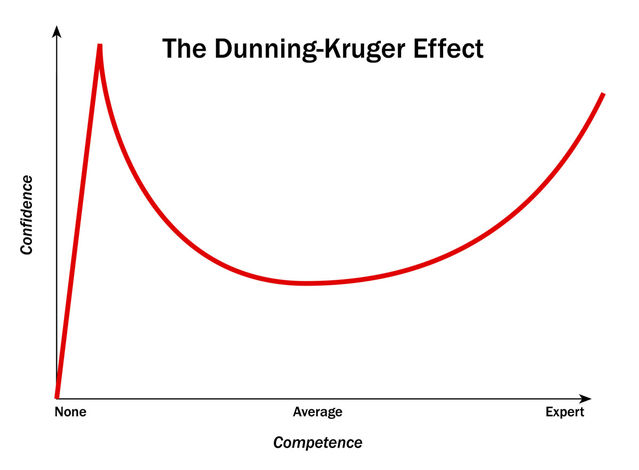
(Right now I'm probably somewhere near to the top of the peak of 'Mt. Stupid' when it comes to the Dunning-Kruger effect itself. I think I've understood it because I've seen the chart and it fits with my experience but I haven't read the studies.)
Edit: Oh and there's another way to look at it as well, for the trough of the chart. For some people I think it's flipped and you have a really sharp dip where you've got the skills but still feel totally incompetent. Imposter syndrome.


We're all caught somewhere on this curve on literally everything we think we understand. (a separate curve for every individual thing)

(Right now I'm probably somewhere near to the top of the peak of 'Mt. Stupid' when it comes to the Dunning-Kruger effect itself. I think I've understood it because I've seen the chart and it fits with my experience but I haven't read the studies.)
Edit: Oh and there's another way to look at it as well, for the trough of the chart. For some people I think it's flipped and you have a really sharp dip where you've got the skills but still feel totally incompetent. Imposter syndrome.


Last edited:
Ironically, and hilariously, many people who're suffering the Dunning-Kruger effect are drawn to self-diagnose imposter syndrome (so that they can get over it)*, and many people with imposter syndrome will themselves relate to Dunning-Kruger (so that they can get over that)**! Which boggles the mind somewhat.
*Due to believing that the actual reality is that they know more than most people about a given subject, which jars directly with their experience of failure to achieve anything substantial with what they believe to be their out of the ordinary level of competence, leading to the typical assumption that their lack of success must be put down to their false perception about the greater competence of others, which in turn (they believe) cripples them with blockages which are experienced as 'anxiety', or a low ability to follow through with plans, or perfectionism, or self-sabotage, and all manner of other novel excuses. All of which might be expected of someone suffering imposter syndrome. (and yet all of which are also, conveniently, perfect excuses for people never to face up to their actual incompetency).
Thus they must suffer imposter syndrome and that's what's holding them back, not their lack of competence.
**Due to believing that, as someone who 'certainly isn't' suffering from imposter syndrome (or so they believe, due to their lack of belief in their level of competence in a given subject resulting from their imposter syndrome), then the actual reality which they perceive (a belief that they know more than most people about a given subject), can only adequately be explained by the Dunning-Kruger effect, and that any fleeting considerations they have that they might know more than most people about a given subject are simply the result of surfing ignorantly away at the peak of the low competence high confidence peak of the Dunning-Kruger curve.
But as I mentioned in my previous post I'm probably at the peak of Mt Stupid when it comes to the Dunning-Kruger effect so you can discount this post accordingly.
*Due to believing that the actual reality is that they know more than most people about a given subject, which jars directly with their experience of failure to achieve anything substantial with what they believe to be their out of the ordinary level of competence, leading to the typical assumption that their lack of success must be put down to their false perception about the greater competence of others, which in turn (they believe) cripples them with blockages which are experienced as 'anxiety', or a low ability to follow through with plans, or perfectionism, or self-sabotage, and all manner of other novel excuses. All of which might be expected of someone suffering imposter syndrome. (and yet all of which are also, conveniently, perfect excuses for people never to face up to their actual incompetency).
Thus they must suffer imposter syndrome and that's what's holding them back, not their lack of competence.
**Due to believing that, as someone who 'certainly isn't' suffering from imposter syndrome (or so they believe, due to their lack of belief in their level of competence in a given subject resulting from their imposter syndrome), then the actual reality which they perceive (a belief that they know more than most people about a given subject), can only adequately be explained by the Dunning-Kruger effect, and that any fleeting considerations they have that they might know more than most people about a given subject are simply the result of surfing ignorantly away at the peak of the low competence high confidence peak of the Dunning-Kruger curve.
But as I mentioned in my previous post I'm probably at the peak of Mt Stupid when it comes to the Dunning-Kruger effect so you can discount this post accordingly.
Last edited:
- Status
- Not open for further replies.
- Home
- Loudspeakers
- Multi-Way
- 10" - 12" (or?) for ~100 Hz - ~2,000 Hz
